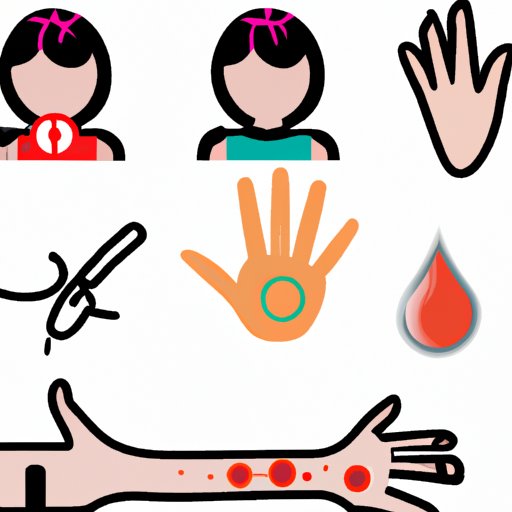Introduction
A tattoo is a form of body art that involves injecting ink into the skin. While tattoos are generally safe, there is still a risk of infection. An infected tattoo is one in which bacteria or other microorganisms have entered the wound, resulting in inflammation and other symptoms.
In this article, we’ll discuss what an infected tattoo is, identify the signs and symptoms of infection, explore the potential causes, understand the risk factors for infection, and go over ways to prevent and treat an infected tattoo.

Identifying the Signs of an Infected Tattoo
If you suspect your tattoo may be infected, it’s important to seek medical attention right away. Here are some of the common signs and symptoms of an infected tattoo:
Redness
The area around the tattoo may appear redder than usual. This can be a sign of inflammation, which can indicate infection.
Swelling
An infected tattoo may also swell more than normal. Swelling can cause the area to feel tight and uncomfortable.
Discharge
If the tattoo is infected, you may notice a yellowish or greenish discharge coming from the area. This can be a sign of pus, which is a mixture of dead tissue, white blood cells, and bacteria.
Pain or Tenderness
An infected tattoo may be painful or tender to the touch. The pain may be mild or severe, depending on the severity of the infection.

Understanding the Causes of Infected Tattoos
There are several potential causes of an infected tattoo. These include:
Poor Hygiene
One of the most common causes of an infected tattoo is poor hygiene. If the artist doesn’t use sterile equipment or practice proper sanitation, it can increase the risk of infection.
Unsterilized Equipment
Tattoo needles and other equipment should always be sterilized before use. If they aren’t, they may contain bacteria or other microorganisms that can cause infection.
Allergic Reaction to Ink or Ointment
Some people may be allergic to the ink used in tattoos or the ointment applied afterwards. This can cause an inflammatory reaction, increasing the risk of infection.
Recognizing the Risk Factors for Tattoo Infection
Certain people may be at an increased risk of developing an infected tattoo. These risk factors include:
Skin Conditions
People with certain skin conditions, such as psoriasis, eczema, or diabetes, may be more prone to infection. It’s important for these individuals to keep their skin clean and moisturized to reduce the risk.
Immunocompromised Individuals
Individuals who are immunocompromised due to illness or medication may be more likely to develop an infected tattoo. They should take extra precautions when getting a tattoo and follow the aftercare instructions closely.
Age
Older adults may be more likely to develop an infected tattoo due to age-related changes in the skin. It’s important for older adults to keep the tattoo clean and dry and to seek medical attention if any signs of infection occur.

Preventing Infection in Newly Inked Tattoos
To help prevent infection, follow these tips when getting a new tattoo:
Choose a Reputable Artist
It’s important to choose a reputable artist who uses sterile equipment and follows proper sanitation procedures. Ask about their experience and look for reviews online.
Follow Aftercare Instructions
Be sure to follow the artist’s aftercare instructions closely. This may include keeping the area clean and dry, avoiding tight clothing, and applying a thin layer of ointment.
Keep the Area Clean and Dry
Clean the area with warm water and mild soap twice a day. Avoid scrubbing the area too hard and pat it dry after cleaning. Apply a thin layer of ointment to keep the area moist.
Treating an Infected Tattoo
If you think your tattoo is infected, seek medical attention right away. Your doctor may recommend the following treatments:
Clean the Area with Warm Water and Mild Soap
Clean the area with warm water and mild soap twice a day. Avoid scrubbing the area too hard and pat it dry after cleaning.
Apply Antibiotic Ointment
Your doctor may prescribe an antibiotic ointment, which should be applied twice a day. Be sure to follow the instructions carefully and avoid using any other ointments or creams.
Take Prescribed Antibiotics
Your doctor may also prescribe antibiotics to help treat the infection. Be sure to take the medication as directed and finish the entire course, even if the symptoms go away.
Conclusion
An infected tattoo is one in which bacteria or other microorganisms have entered the wound, resulting in inflammation and other symptoms. To help prevent infection, choose a reputable artist, follow the aftercare instructions, and keep the area clean and dry. If you think your tattoo is infected, seek medical attention right away.
By understanding the signs and symptoms of an infected tattoo, identifying the potential causes, recognizing the risk factors, and following preventive measures, you can help reduce your risk of infection and ensure your tattoo heals properly.
(Note: Is this article not meeting your expectations? Do you have knowledge or insights to share? Unlock new opportunities and expand your reach by joining our authors team. Click Registration to join us and share your expertise with our readers.)
